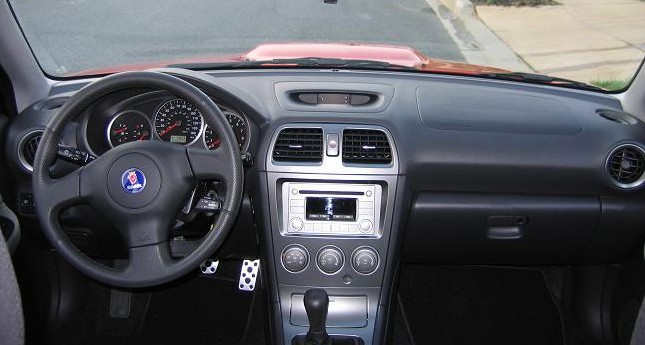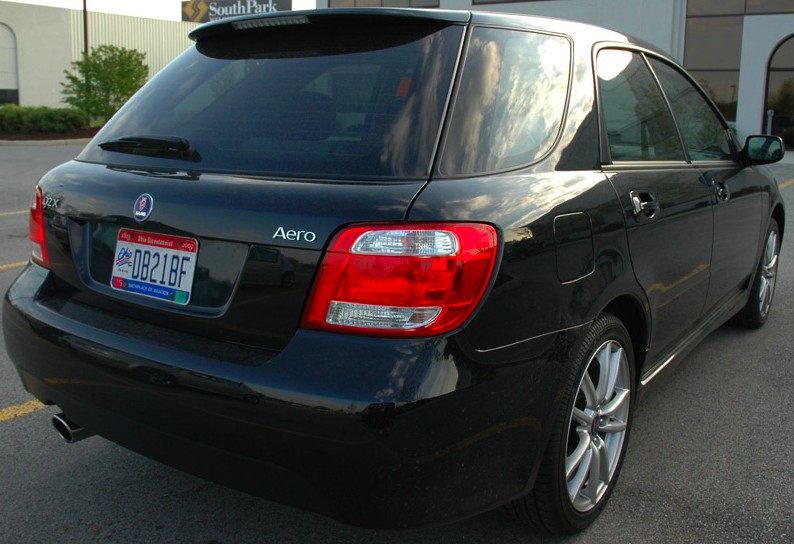Automotive collaborations can sometimes lead to unexpected and intriguing vehicles. For enthusiasts, these cross-brand creations often become cult classics, celebrated for their unique blend of different automotive philosophies. Enter the Saab 9-2x, affectionately nicknamed the ‘Saabaru’ – a car that perfectly embodies this fascinating intersection. Born from a collaboration between Swedish Saab and Japanese Subaru in the early 2000s, the 9-2x is a model that many, even dedicated Saab or Subaru fans, might not be fully acquainted with.
 Close-up of Saab 9-2x front with Saab badging and headlights, highlighting its Subaru Impreza origins.
Close-up of Saab 9-2x front with Saab badging and headlights, highlighting its Subaru Impreza origins.
So, what exactly is the Saab 9-2x? In essence, it’s a rebadged second-generation Subaru Impreza wagon. Produced for the North American market for just two model years, 2005 and 2006, the Saab 9-2x was an attempt to broaden Saab’s appeal and tap into the sporty compact car segment. Built at Subaru’s Gunma, Japan factory, the 9-2x took the solid foundation of the Impreza and infused it with subtle Saab design cues and characteristics. While the sheet metal changes were minimal, primarily focusing on the front and rear fascias to incorporate Saab’s design language, the Saab 9-2x was more than just a badge-swapping exercise.
Beneath the Saab-ified skin, the 9-2x offered the renowned Subaru symmetrical all-wheel drive system and a choice of two engine options, mirroring the Impreza lineup. The base ‘Linear’ trim featured a naturally-aspirated 2.5-liter engine, delivering around 171 horsepower, providing adequate performance for everyday driving. However, for those seeking a more exhilarating experience, the ‘Aero’ trim was the answer. The Saab 9-2x Aero boasted the iconic turbocharged 2.0-liter Subaru engine, pumping out a more spirited 227 horsepower and 235 lb-ft of torque. This engine, familiar to WRX enthusiasts, gave the Saabaru a distinctly sporty character, further enhanced by a quicker steering rack borrowed from the Subaru Impreza WRX STI. Saab also made efforts to refine the Impreza’s driving experience, adding improved acoustic insulation for a quieter cabin and active head restraints to enhance safety.
 Side view of a silver Saab 9-2x, showcasing its wagon silhouette and subtle Saab design cues on a Subaru chassis.
Side view of a silver Saab 9-2x, showcasing its wagon silhouette and subtle Saab design cues on a Subaru chassis.
Despite its intriguing concept – a blend of Swedish sophistication and Japanese engineering, offering a more refined take on the Subaru WRX formula – the Saab 9-2x ultimately faced a short production run. Sales figures fell short of expectations, with fewer than 10,500 units produced during its two-year lifespan. Several factors contributed to its lukewarm reception, including its relatively high price point compared to the Subaru Impreza and perhaps a lack of clear market positioning. Was it sporty enough for WRX enthusiasts? Was it luxurious enough for traditional Saab buyers? The Saab 9-2x, while conceptually appealing, seemed to occupy an awkward middle ground.
Nevertheless, the Saab 9-2x remains a fascinating footnote in automotive history. It represents a unique collaboration and a rare example of badge engineering done with a degree of thoughtful differentiation. For those in the know, the ‘Saabaru’ holds a certain appeal, a quirky and somewhat obscure model that blends the best of two distinct automotive worlds into one often-overlooked package. It might just be one of the most interesting Saabs that many have never even heard of.